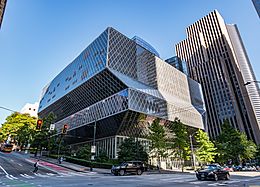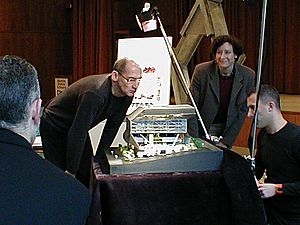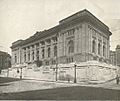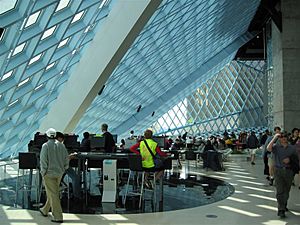Seattle Central Library facts for kids
Quick facts for kids Seattle Central Library |
|
|---|---|

Seattle Central Library in 2019
|
|
| General information | |
| Type | Public Library |
| Location | 1000 Fourth Avenue Seattle, Washington, U.S. |
| Coordinates | 47°36′24″N 122°19′57″W / 47.606699°N 122.332503°W |
| Construction started | 2002 |
| Completed | 2004 |
| Opening | May 23, 2004 |
| Cost | $165.9 million |
| Owner | Seattle Public Library |
| Height | |
| Architectural | 196 ft (60 m) |
| Roof | 185.01 ft (56.39 m) |
| Technical details | |
| Floor count | 11 |
| Floor area | 362,987 sq ft (33,700 m2) |
| Design and construction | |
| Architect | LMN Architects/Office for Metropolitan Architecture |
| Developer | Seattle Public Library |
| Structural engineer | Magnusson Klemencic Associates with Arup Group Limited |
| Main contractor | Hoffman Construction Company |
The Seattle Central Library is the flagship library of the Seattle Public Library system. The 11-story (185 feet or 56.9 meters high) glass and steel building in downtown Seattle, Washington was opened to the public on May 23, 2004. Rem Koolhaas and Joshua Prince-Ramus of OMA/LMN were the principal architects, and Magnusson Klemencic Associates was the structural engineer with Arup. Arup also provided mechanical, electrical, and plumbing engineering, as well as fire/life safety, security, IT and communications, and audio visual consulting. Hoffman Construction Company of Portland, Oregon, was the general contractor.
The 362,987 square feet (33,722.6 m2) public library has the capacity to hold about one and a half million books and other materials. It offers underground public parking for 143 vehicles and over 400 computers accessible to the public. Over two million people visited the library during its first year. It is the third Seattle Central Library building to be located on the same site at 1000 Fourth Avenue, the block bounded by Fourth and Fifth Avenues and Madison and Spring Streets. The library has a unique, striking appearance, consisting of several discrete "floating platforms" seemingly wrapped in a large steel net around glass skin. Architectural tours of the building began in June 2004.
In 2007, the building was voted #108 on the American Institute of Architects' list of Americans' 150 favorite structures in the U.S. It was one of two places in Seattle to be included on the list of 150 structures, the other being T-Mobile Park.
Contents
History
There has been a library located in downtown Seattle as far back as 1891; however, the library did not have its own dedicated facilities and it was frequently on the move from building to building. The Seattle Carnegie Library, the first permanent library located in its own dedicated building at Fourth Avenue and Madison Street, opened in 1906 with a Beaux-Arts design by Peter J. Weber. Andrew Carnegie, whose patronage of libraries later included five others in Seattle, donated $200,000 for the construction of the new library. That library, at 55,000 square feet (5,100 m2), with an extension built in 1946, eventually became too small and cramped for a city population that, by the time the library was replaced, had roughly doubled since the library's first opening.
A second library, at five stories and 206,000 square feet (19,100 m2), was built at the site of the old Carnegie library in 1960. The new building designed by architects Bindon and Wright, with Decker, Christenson, and Kitchin as associates, featured an international-style architecture and an expanded interior, with features such as drive-thru service to offset the lack of available parking. George Tsutakawa's "Fountain of Wisdom" on the Fifth Avenue side (relocated to Fourth Avenue in the current library) was the first of that artist's many sculptural fountains. A remodeling finished in 1972 gave the public access to the fourth story, dedicated to the arts and sound recordings. By the late 1990s, the library became too cramped again and two-thirds of its materials were held in storage areas inaccessible to patrons. Renewed consciousness of regional earthquake dangers drew concern from public officials about the seismic risks inherent to the building's design.
Renovation

The current Seattle Central Library is the third library building to inhabit the city block between Fourth and Fifth Avenues. Funding for the new Seattle Central Library building, as well as other construction projects throughout the library system, was provided by a $196.4 million bond measure, called "Libraries for All," approved by Seattle voters on November 3, 1998. The project also received a $20 million donation from Bill Gates, of Microsoft.
Rem Koolhaas and Joshua Prince-Ramus of the Dutch firm Office for Metropolitan Architecture (OMA), working in conjunction with the Seattle firm LMN Architects, served as the building's principal architects. Ramus served as the partner in charge. Bjarke Ingels designed the interior boxes for OMA. OMA was not one of the firms invited to compete for the project. Ramus, formerly a Seattle resident, found out from his mother one day in advance that the library board was inviting interested firms to attend a mandatory public meeting. He flew in, and OMA ended up winning the project.
Deborah Jacobs, Chief Librarian in the Seattle Public Library system, spearheaded the project from the library's perspective and served as the primary client voice, while Betty Jane Narver served as president of the Library Board.
Design
The architects conceived the new Central Library building as a celebration of books, deciding after some research that despite the arrival of the 21st century and the "digital age," people still respond to books printed on paper. The 11-story Central Library has a capacity for over 1.5 million books, in comparison to only 900,000 in the old library building. The architects also worked to make the library inviting to the public, rather than stuffy, which they discovered was the popular perception of libraries as a whole.
Although the library is an unusual shape from the outside, the architects' philosophy was to let the building's required functions dictate what it should look like, rather than imposing a structure and making the functions conform to that.
For example, a major section of the building is the "Books Spiral," (designed to display the library's nonfiction collection without breaking up the Dewey Decimal System classification onto different floors or sections). The collection spirals up through four stories on a continuous series of shelves. This allows patrons to peruse the entire collection without using stairs or traveling to a different part of the building.
Other internal features include; the Microsoft Auditorium on the ground floor, the "Living Room" on the third floor (designed as a space for patrons to read), the Charles Simonyi Mixing Chamber (a version of a reference desk that provides interdisciplinary staff help for patrons who want to have questions answered or do research), and the Betty Jane Narver Reading Room on level 10 (with views of Elliott Bay).
New functions include automatic book sorting and conveyance, self-checkout for patrons, pervasive wireless communications among the library staff, and over 400 public computer terminals.
Additional images
- Rawlinson, Linnie. 'Creating the perfect public space: Seattle Central Library', CNN, 2 August 2007. With image gallery.
- Muschamp, H. (May 16, 2004). The library that puts on fishnets and hits the disco. The New York Times.
- The 2004 Annual Report (PDF) of the library system includes many images of the library, brief biographies of the artists whose work was incorporated into the structure, etc.
See also
 In Spanish: Biblioteca Central de Seattle para niños
In Spanish: Biblioteca Central de Seattle para niños














